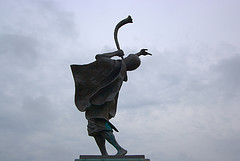CG7 Meridian, SDAs, and the Seventh Month Movement

Tom Roberts of CG7 Meridian (not to be confused with the vastly larger CG7-Denver) wrote the following:
In 1858, Gilbert Cramer from the Marion Party, founded eight churches which would ultimately become the Church of God Seventh Day. Out of this ministry arose the Remnant of Israel under the leadership of G. G. Rupert who definitely advocated the meaning of Holy Day observance. (“Remnant of Israel”, G. G. Rupert, Vol 10, No. 11, September, 1929) Some today are suggesting that G. G. Rupert was a delegate at the 1888 Seventh Day Adventist Conference which began the change of direction of the SDA Church from its founders with the departure of Wagner and Jones. This conference was very significant because its theme was “Righteousness by Faith” and was needed to free Sabbatarians from legalism. Unfortunately, as the years passed, many of the founding voices of Adventism who once gave support to the Seventh Month Movement were no longer influential. Ellen White even stated that the Adventist camp meetings should replicate the Feast of Tabernacles…
As the years progressed, Adventist scholars such N. L. Andreason, Raymond Cottrell, Ken Richards, Desmond Ford, and many others began to question the classical Adventist positions taught about the history of their beginnings and the direction the church was taking. There were those who wanted to go back to the non-trinitarian, Holy Day, Kingdom of God on earth positions of the church. Others such as Desmond Ford, wanted the church to move in an evangelical direction while some at La Sierra University have tried to place the church on a more progressive path. Once again, the church is beginning to denounce all feast day keepers. Angel Rodriguez, PhD, and others have denounced the entire feast day movement. In spite of this, the ethos of feast day movements are still are behind the thinking of much of Seventh Day Adventist theology. One such example is Leslie Hardinge’s In the Shadow of His Sacrifice. He does an absolutely brilliant job of teaching Christianity the meaning of the Holy Days and the lessons that should impact their thinking about the Messiah.
Today there is a growing but small number of small groups of Adventist Holy Day Keepers who are attempting to resurrect the Seventh Month Movement in the Adventist Church. Dr. John Vandenberg is leading the charge along with a few other scholars and pastors by showing the Seventh Month Movement should never have been buried in Adventist history but instead modified to exclude its theological errors. It should have retained the spirit of Holy Day keeping in the worship and the life of the church.
Let us all pray and support this movement and fellowship with them as offer our love and service.
The reasons for the term “Seventh Month Movement” include the fact that the seventh month in the Hebrew calendar is called Tishri, the first day of it is the Feast of Trumpets, and all the Fall Holy Days occur in the seventh month of the Hebrew calendar. Hence “Seventh Month Movement” connotes observance (to some degree) of the biblical Fall Holy Days.
We in the Living Church of God (as well as other groups, like CG7 Meridian) observe and endorse the biblical Fall Holy Days of the seventh month.
Some groups, like CG7-Denver, allow for the observance of the Fall Holy Days, but will not endorse them. There are also some within the Seventh-day Adventist movement that endorse the holy days, but they are a minority.
The late SDA scholar Samuele Bacchiochi not only endorsed the biblical holy days late in his life, he also wrote books about them (which I purchased and read) explaining why he felt that they had biblical and historical support for their observances, as well as even some statements from Ellen White hinting that she supported their observance.
Every now and then, I hear from some associated with the SDA movement who recognize that doctrinal compromise has occurred within it and that they lean more towards Church of God doctrines in certain areas.
Some articles of possibly related interest may include:
Did Early Christians Observe the Fall Holy Days? Did they? Did Jesus? Should you?
The Book of Life and the Feast of Trumpets? Are they related? Is so how? If not, where not?
The Day of Atonement–Its Christian Significance The Jews call it Yom Kippur, Christians “The Day of Atonement”. Does it have any relevance for Christians today?
The Feast of Tabernacles: A Time for Christians? Is this pilgrimage holy day still valid? Does it teach anything relevant for today’s Christians? What is the Last Great Day? What do these days teach?
LCG 2011 Feast of Tabernacles’ Information Here is information on many Feast of Tabernacles locations for this “seventh month” feast.
What Does the Catholic Church Teach About Christmas and the Holy Days? Do you know what the Catholic Church says were the original Christian holy days? Was Christmas among them?
Holy Day Calendar This is a listing of the biblical holy days through 2012, with their Roman calendar dates. They are really hard to observe if you do not know when they occur ![]()
SDA/LCG Differences: Two Horned Beast of Revelation and 666 The Living Church of God is NOT part of the Seventh-day Adventists. This article explains two prophetic differences, the trinity, and differences in approaching doctrine, including Ellen White. It also answers the question, “Did Ellen White make clear prophetic errors?”
 |
Tweet |
|